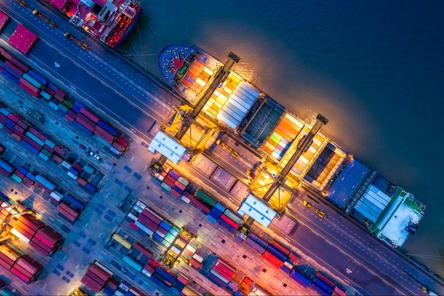Sea freight logistics is a common shipping method, especially when goods need to travel a long distance. How does this shipping method fit into the supply chain as a whole? Here we’ll discuss what sea freight logistics is, how it fits into the supply chain, the pros and cons of using sea freight shipping, and some tips for choosing the right sea freight forwarder.
WHAT IS SEA FREIGHT LOGISTICS?
Sea freight logistics is a process that involves the planning and transportation of freight by cargo ship. Most often, freight is loaded onto containers that are placed on an ocean carrier. Containers are then moved via ocean to their destination.
This mode of transportation is often aided by a sea freight forwarder or an agent that facilitates ocean freight shipments using their unique knowledge base and connections to ensure cost-effective and efficient services. Sea freight services are commonly used to ship raw materials or components from Asia to factories and/or warehouses in Europe or North America.
HOW DOES SEA FREIGHT FIT INTO THE SUPPLY CHAIN?
The role of sea freight in the supply chain is generally to move large quantities of goods from one continent to another.
Sea freight forwarders are an important link in the supply chain as they coordinate the entire logistics process - from export to shipping via ocean carriers to import. Thanks to international trade and maritime laws, shipping via ocean can be complicated, and freight forwarders can help demystify the process and leverage their connections across the supply chain to ensure it goes smoothly for their customers.
Though sea freight transport often involves the longest leg of a product’s journey through the supply chain, it just makes up some of the supply chains’ links. First, goods must move from the supplier to the port where the carrier is loading containers. Once the shipment has arrived at the port of destination, drayage services are often utilized to move the item from the port to a storage facility. From there, containers are often taken via rail or truck to a warehouse to be unloaded.
TYPES OF SEA FREIGHT SHIPPING
There are four main types of sea freight shipping:
- Full container load (FCL)- FCL sea freight involves the shipment of a full container or more than one container of goods.
- Less than container load (LCL)- LCL sea freight combines shipments from multiple different shippers into one container and is ideal when a shipper needs products moved via ocean but doesn’t have a full container of goods.
- Dry bulk shipping- This specialized ocean freight shipping method involves the placement of certain dry goods directly into the hold of an ocean carrier rather than in a container that is then moved onto the ship.
- Roll on, Roll Off (RORO)- This type of ocean shipping is used for items like vehicles that don’t need to be containerized to be moved onto the ship. Instead, they are rolled or driven directly onto the cargo ship and secured, then rolled or driven off the ship at the destination.
THE BENEFITS AND DISADVANTAGES OF USING SEA FREIGHT LOGISTICS
Like any other shipping method, there are upsides and downsides to shipping cargo via sea freight logistics.
THE BENEFITS OF SEA FREIGHT SHIPPING
One of the biggest benefits of sea freight shipping is that it’s cost-effective, especially when utilized for long trips. Sea freight shipping allows you to send large quantities of goods at the same time at a cost significantly lower than shipping via other methods. For instance, Cargo vessels can carry an average of 18,000 containers, meaning each ship can move a large amount of cargo in each shipment. The high volume of cargo containers on each ship makes it less expensive than other shipping methods per container. Sea freight shipping, whether you’re using full container load (FCL) or less than container load (LCL), is far more inexpensive than moving similar amounts of freight via air.
Thanks to the large volume of cargo on each ship, sea freight shipping has a smaller carbon footprint than other shipping methods. That makes it a great option for companies looking to reduce their environmental impact.
Ocean freight shipping is a great option for large, heavy, or bulky items since the weight doesn’t have as much impact on shipping as it does in other cross-ocean shipping methods, like air freight.
THE DOWNSIDES OF SEA FREIGHT SHIPPING
The biggest downfall of sea freight shipping is that it takes time. A giant carrier ship can’t cross an entire ocean in a couple of days as an airplane can. The loading and unloading of the ship can tack on extra time to the journey, as well.
Sea freight shipping is not a great option for smaller quantities of goods, even if you plan to ship your items LCL. It can be cost-prohibitive if you don’t have a certain amount of items, making air freight or courier services more efficient and likely faster.
HOW TO CHOOSE A SEA FREIGHT FORWARDER
When you’re choosing a sea freight forwarder, there are some factors you can take into consideration to find the right provider for your company. Some forwarders focus on specific types of shipments, shipment methods, or other factors, so be sure to check with potential forwarders on the types of shipments they’ve handled in the past.
Consider these questions when you’re shopping for a sea freight forwarding partner:
- What kind of freight volume are you looking at shipping?
- How often will you need shipments?
- What kind of merchandise are you shipping?
- How fast do you need the merchandise?
- Will you have enough freight to fill a whole container?
- If you don’t need a full container, will you have enough freight to make LCL practical from a cost perspective?
WHY CHOOSE SEKO FOR SEA FREIGHT LOGISTICS?
SEKO’s global logistics service offerings include ocean freight forwarding. Our vast network of logistics providers across the globe and NVOCC license mean we can offer flexible, customized ocean freight solutions to our customers. For example, the SEKO team designed an ocean freight solution to help Ember expand operations to 26 countries. Reach out to our team here to inquire about our services.





